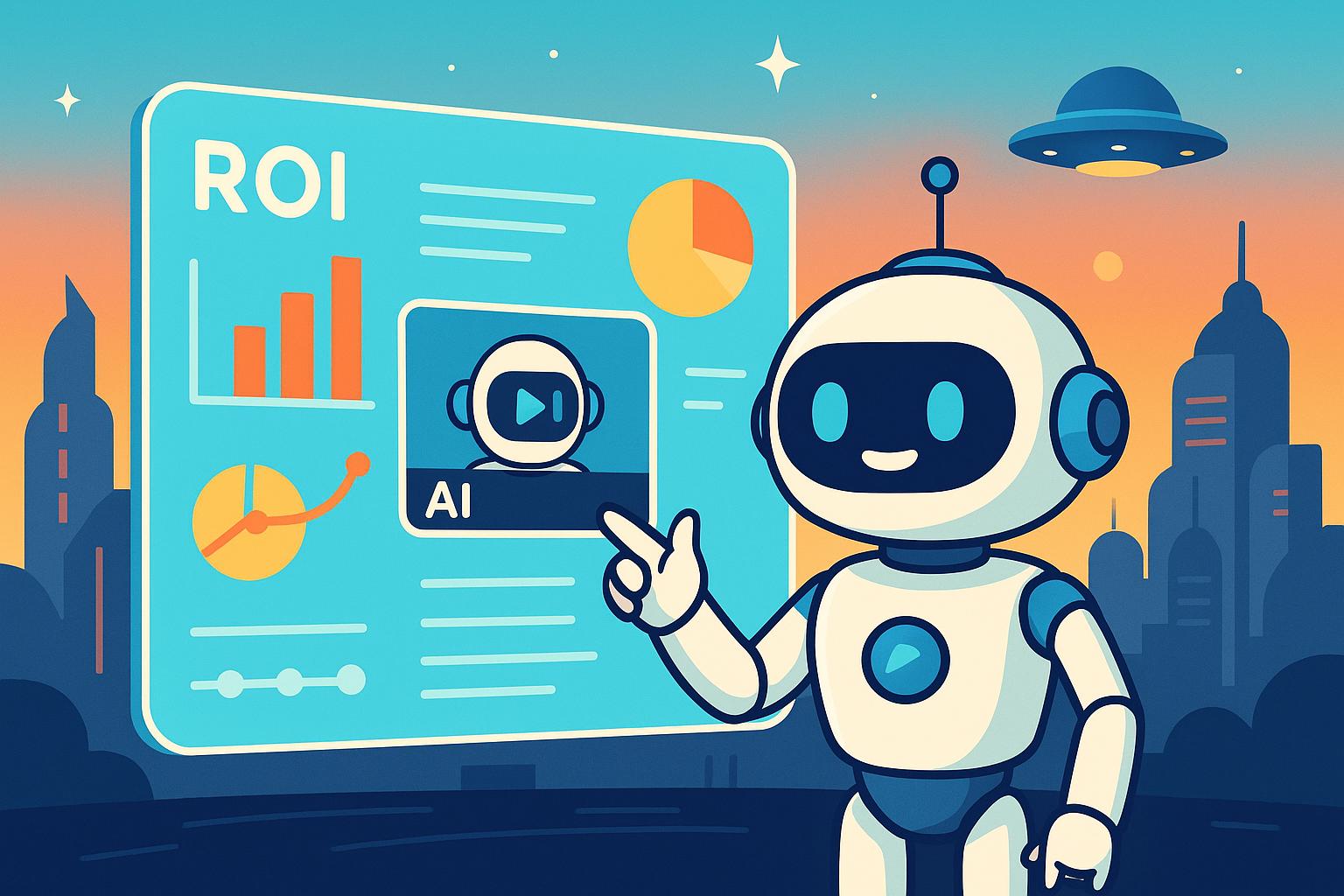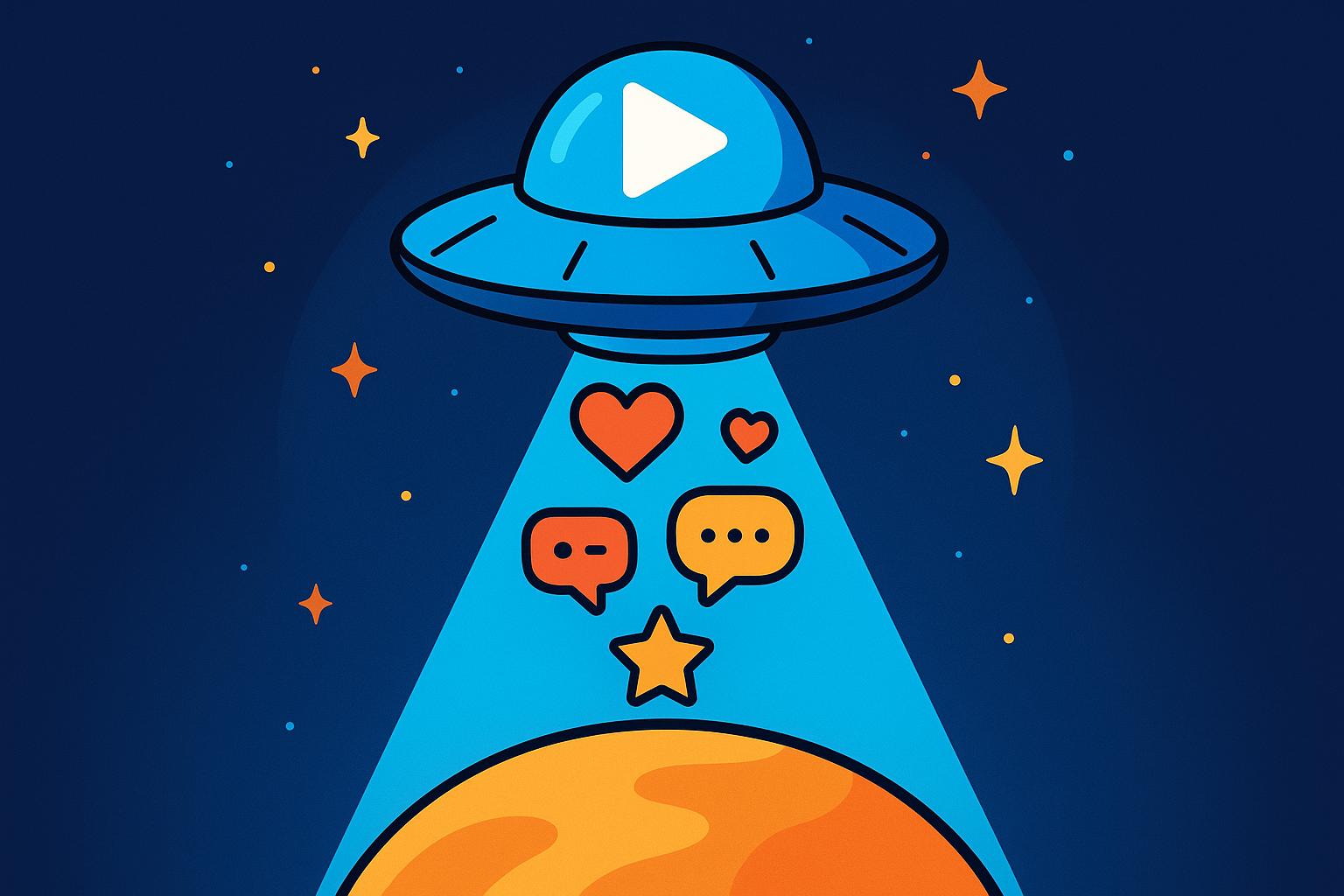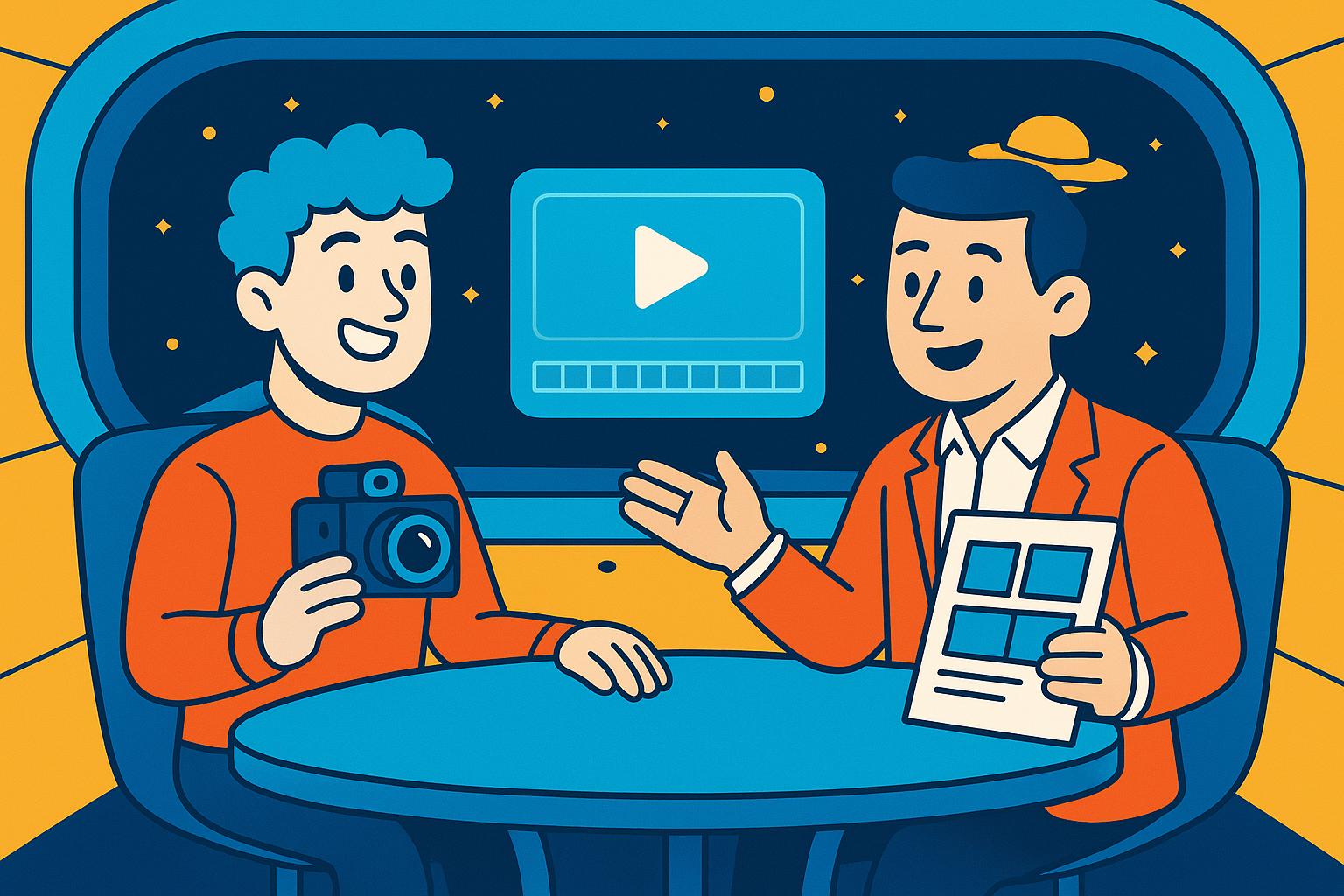AI-powered video personalization is reshaping how businesses engage with audiences. By tailoring content to individual preferences, companies are seeing measurable improvements in engagement, conversions, and ROI. Here's a quick look at how four industries are leveraging this technology:
- E-commerce: Automated video creation helped an eyewear retailer cut production time by 80%, reduce costs, and boost customer engagement by 35%. Conversion rates increased by 20%, with fewer product returns.
- SaaS: ClearCalcs used AI to create role-specific onboarding videos, improving user recall by 13% and reducing churn. Tailored feature demos further enhanced product adoption.
- Financial Services: Webb Loans personalized client outreach with videos addressing individual financial profiles, increasing retention by 15% and engagement by 75%.
- Education: Platforms like Khan Academy localized video lessons into 20+ languages, increasing engagement by 40% in non-English-speaking regions while cutting production time significantly.
These examples highlight how AI video personalization is delivering better outcomes, from higher engagement to cost savings, across diverse sectors.
How 3 Brands Used AI To Personalize Content At Scale And Won
E-commerce: Automated Product Video Creation
A prominent eyewear retailer transformed its online marketing strategy by adopting AI-powered video creation to tackle challenges like slow production timelines, high costs, and a lack of personalization. With 91% of consumers in 2025 emphasizing that video quality influences their trust in a brand, finding a scalable solution became a top priority.
Key Results
The shift to AI-driven video automation brought impressive results. Production time was slashed by 80%, turning a process that once took weeks into just a matter of hours. This approach significantly reduced costs by eliminating the need for expensive equipment and extensive editing. It also boosted customer engagement by 35%, with viewers spending 30% more time watching videos. Conversion rates saw a lift of up to 20%, while product returns dropped by 40%. These improvements contributed to a 44% increase in repeat visits.
How AI Improved Product Presentation
By combining virtual try-on technology with customer analytics, the AI system created personalized videos tailored to individual preferences. The platform handled everything from scriptwriting to SEO optimization, ensuring that the content resonated with the target audience. Using structured asset libraries and templates, the system maintained brand consistency while integrating seamlessly with the retailer's CRM to deliver customized experiences.
For businesses aiming to adopt similar AI video solutions, tools like Paracast.io simplify the process. These platforms allow users to generate promotional videos directly from website URLs, using pre-designed templates for product demos and business announcements.
This case highlights how AI can revolutionize product presentations in e-commerce, paving the way for similar advancements in SaaS and other industries.
SaaS: Custom Onboarding and Feature Demos
ClearCalcs, a structural design software company, revamped its user onboarding process by using AI to create personalized video content for its diverse audience, which includes engineers, architects, and construction professionals. By segmenting users based on their roles, ClearCalcs utilized AI to deliver tailored onboarding videos, making it easier for users to get started and reducing friction in the process.
Better User Experience
With 86% of customers staying loyal after a successful onboarding experience, ClearCalcs focused on creating role-specific video tutorials to address the unique challenges faced by each user group. Their AI system analyzed customer data, including industry, use cases, and behavior patterns, to generate customized walkthroughs and training materials. This eliminated the need for extensive production efforts while delivering content that felt personal and relevant.
"It's great, because it's work that people hated doing: activity logging, meeting notes, recaps to customers. There was some value in it because it forces you to synthesize and summarize and prioritize and all of that. But this work, we can now just totally automate today through AI."
– Gillian Heltai, Chief Customer Officer at Haus
This personalized approach led to a 13% increase in recall and higher video view times. Additionally, AI-powered chatbots provided real-time, customized support, further enhancing the user experience.
These efforts also set the stage for more effective and engaging feature demonstrations.
Higher Adoption Through Personalization
ClearCalcs took its personalization efforts a step further by using AI to create custom feature demos for different buyer segments. By 2024, 78% of Customer Success teams had adopted or were in the process of implementing AI technologies, highlighting the growing trend of using AI for personalization across the SaaS industry. ClearCalcs also leveraged AI to generate avatars for video demos, making it easier to scale the production of tailored content.
Given that up to 75% of customers reject products with poor onboarding experiences, these personalized feature demos played a key role in boosting user engagement and reducing churn.
For SaaS companies looking to replicate this success, platforms like Paracast.io offer tools to streamline the creation of custom onboarding and feature demo videos.
"My primary role is to make everything so convenient and intuitive that users don't even think of it as GPT integration. But the real challenge is to ensure that SaaS users trust AI – especially in business contexts where errors are unacceptable, and users often delegate control to the program."
– Nazar Neshcheret, Leading Designer, Eleken
ClearCalcs’ approach showcases how AI-driven personalization can turn onboarding from a generic process into a role-specific experience that significantly improves user adoption and satisfaction.
sbb-itb-5bfa442
Financial Services: Stronger Client Relationships
Webb Loans completely revamped how they connect with potential clients by rolling out AI-powered personalized video campaigns. These videos didn’t just send a generic message - they spoke directly to each prospect, addressing their unique financial profiles. For example, the videos greeted clients by name and broke down mortgage options tailored to their specific situations. This approach shifted Webb Loans from being just another faceless financial service to becoming a trusted partner in their clients’ financial journeys.
The secret behind this transformation? AI-driven data analysis. By creating 360-degree customer profiles, Webb Loans could deliver hyper-personalized interactions that resonated with each recipient. These videos weren’t just informative - they showed a deep understanding of individual needs, which helped build trust and engagement right from the start. This method proved especially impactful in the mortgage sector, where clients often find the process daunting. The result was a noticeable boost in client engagement and outreach effectiveness.
"After trying a few AI-generated video platforms with no success, I found Gan.AI. They have shown to be a far superior offering both in technology and customer service."
– Adrian Webb
Impact of Personalized Outreach
With improved engagement metrics in hand, financial institutions took personalized outreach even further. For instance, one major bank saw a 15% increase in customer retention by using personalized explainer videos to clarify financial products. Across the board, financial services using tailored videos reported a 75% higher engagement rate compared to traditional text-based communications, a 29% increase in digital tool adoption, and a 12% rise in account applications .
The impact didn’t stop there. Clients who watched personalized onboarding videos increased their savings contributions by an astounding 550% more than those who skipped the content. Customer satisfaction also skyrocketed, with personalized videos driving a 48-point jump in Net Promoter Score (NPS).
"We see feedback where clients tell us the video helped them understand the program much better. As a result of that greater understanding, they engage deeper and bring in more assets to move up the ladder in the program."
– John Sellers, Preferred Rewards Executive
Using AI for Custom Messaging
AI technology has enabled financial institutions to create video content that feels genuinely personal. By analyzing a wealth of customer data - like demographics, transaction history, and preferences - AI systems could craft messages that spoke directly to each client’s needs.
This personalization went far beyond simply adding a name to a video. AI allowed for real-time customization, adjusting content based on live data and customer behavior patterns. This meant clients received up-to-date information relevant to their current financial goals and situations. Features like personalized greetings, data visualizations of account performance, and tailored calls to action made the experience even more engaging.
One global financial institution partnered with an AI-driven marketing provider to overhaul its messaging strategy, leading to a 14% increase in ad click-through rates. Email campaigns featuring AI-generated subject lines and content saw a 21% boost in open rates and a 17% rise in conversions. These results, with conversion improvements often hitting 20-30% across various financial products, highlight how personalized video content isn’t just effective at enhancing the client experience - it also delivers measurable business outcomes.
"The results have been astounding. The AI-generated copy not only resonates with our audience but also brings fresh creativity to our campaigns. We never imagined AI could be this effective in creating compelling content."
– Chief Marketing Officer, Global Financial Institution
Education: Scalable Multilingual Video Lessons
Khan Academy has taken a major leap in making education accessible worldwide by using AI to localize its content into over 20 languages. This effort has resulted in a 40% increase in engagement from non-English-speaking regions. Instead of just adding subtitles, the platform has crafted fully localized experiences, adapting course materials to fit different cultural contexts while maintaining the same educational standards. This approach tackles a critical issue: the global lack of educational resources available in native languages.
AI's role in education goes beyond personalization - it’s breaking down language barriers. For instance, 40% of students worldwide don’t have access to courses in their native language. Traditional localization methods were expensive and time-consuming. Now, AI-powered tools for transcription, translation, and dubbing have cut production times from weeks to mere hours while ensuring consistency in quality.
Duolingo has also embraced this shift, enhancing its localized courses and seeing a 30% boost in user retention in non-English-speaking markets. Studies show that students learning in their native language are up to 60% more likely to meet reading comprehension goals by the end of primary school. To address this, Duolingo has invested heavily in AI-driven localization, making learning accessible to a broader audience.
Localization Results
The impact of AI-driven multilingual video lessons is clear from the data. LinkedIn Learning, for example, saw a 35% increase in enrollments after incorporating subtitles and dubbing into its courses. In schools, the benefits are equally striking. A large K–12 district in the Midwest reported a 15% rise in average standardized math scores over two years after integrating localized AI video lessons. In another case, a high school science department noted a 20% improvement in concept retention after adopting interactive, AI-enhanced video materials.
AI has also simplified the once-complex process of video production. Tasks like placing subtitles, integrating voiceovers, and resizing video content are now automated. This automation allows educational organizations to produce content in dozens of languages all at once, making it easier to connect with diverse audiences around the globe.
Engaging Learners Through AI
AI doesn’t just make content more accessible - it also makes it more engaging. Features like AI avatars and voice synthesis ensure consistency in tone and style while providing real-time translations and synchronized voiceovers. Advanced video analytics further enhance engagement by tracking student interactions and adapting content on the fly. These AI-powered lessons have led to a 30–47% boost in engagement, a reduction in dropout rates by up to 35%, and a more than 40% increase in course completion rates.
Additionally, machine learning algorithms tailor content difficulty based on individual performance, creating a personalized feedback loop that helps students stay on track and achieve better results. This combination of localization and adaptive learning tools is reshaping how education reaches and resonates with learners everywhere.
Conclusion
The success of AI-driven video personalization across industries like e-commerce, SaaS, financial services, and education highlights its ability to revolutionize audience engagement. By delivering tailored messages, businesses are connecting with their audiences on a deeper level.
"Content personalization is the future of marketing. AI allows us to create unique experiences for every customer."
– Jeff Bezos, Amazon founder
The numbers speak volumes. Companies using AI for personalization report up to a 25% improvement in ROI and a 20% increase in sales, alongside doubled engagement rates and significant cost savings. In fact, 59% of marketers are already leveraging AI to enhance their personalization efforts. Fully integrating AI into marketing workflows can lead to a 15–20% boost in ROI, and the global AI marketing market is projected to hit $47.32 billion by 2025, with 88% of marketers incorporating AI into their daily operations.
Scalability is another major advantage. Industry leaders like Netflix and Amazon showcase how AI personalization drives results. Netflix saves roughly $1 billion annually by reducing churn, while Amazon attributes around 35% of its e-commerce revenue to its AI-powered recommendation engine.
These examples show that AI personalization not only delivers immediate results but also paves the way for future innovation. The technology is evolving from reactive personalization to predictive anticipation, enabling businesses to anticipate customer needs before they even arise. Tools like Paracast.io are making these advancements accessible to startups, agencies, and smaller teams, leveling the playing field once reserved for large corporations.
"The ability to segment customers and deliver personalized experiences is a game-changer for marketers."
– Marc Benioff, Salesforce CEO
Looking ahead, the next wave of AI personalization promises to further redefine how businesses engage with their customers. As consumer expectations grow - with 80% of shoppers more likely to buy from brands offering personalized experiences - AI video personalization is quickly becoming a must-have for staying competitive. These case studies illustrate that adopting AI doesn't just improve technology - it transforms communication, creating more meaningful connections in an increasingly digital world. Businesses that embrace AI-driven video personalization are positioning themselves for sustained success and a stronger competitive edge.
FAQs
How does AI video personalization improve customer engagement and boost conversion rates across industries?
AI-powered video personalization is transforming how businesses engage with their audiences by crafting content that aligns with individual preferences. By making videos more relevant and tailored, this approach doesn't just grab attention - it resonates. In fact, research highlights that personalized videos can boost click-to-open rates by up to 16 times, while also fostering greater customer satisfaction and loyalty. It's a way for businesses to forge stronger, more meaningful connections with their audience.
When it comes to driving results, the impact is just as impressive. AI-driven personalization has been shown to increase conversion rates by as much as 30%, delivering a direct lift in sales and marketing outcomes. Industries like e-commerce, SaaS, and education are already reaping the rewards, as customized video content not only captures engagement but also motivates viewers to take action.
What challenges do businesses face with AI-driven video personalization, and how can they address them?
Implementing AI-driven video personalization isn’t without its hurdles. Some of the big challenges include data privacy concerns, technical roadblocks like outdated systems or data silos, and a lack of authenticity in the content produced. On top of that, businesses might face ethical dilemmas, such as algorithmic bias, or struggle to find skilled professionals to manage and optimize AI tools effectively.
To tackle these issues, companies need to take a proactive approach. Start by establishing transparent data policies to build trust with users. Investing in up-to-date technology infrastructure can help eliminate technical barriers, while employee training programs can equip teams with the skills needed to manage AI tools in-house. Additionally, creating clear ethical guidelines and aligning AI strategies with business goals and customer needs can ensure a smoother, more responsible implementation.
How can businesses evaluate the ROI and customer satisfaction benefits of AI-powered video personalization?
Businesses can measure the return on investment (ROI) of AI-driven video personalization by weighing the financial benefits - like higher sales or lower churn rates - against the costs of adopting the technology. Metrics such as conversion rates, customer retention, and engagement levels provide a clear picture of its effectiveness.
Customer satisfaction can be gauged using tools like feedback surveys, Net Promoter Scores (NPS), and by tracking behavioral trends such as repeat purchases or extended viewing durations. Additionally, AI-powered analytics can predict long-term outcomes, helping companies fine-tune their strategies to boost both ROI and customer loyalty.


